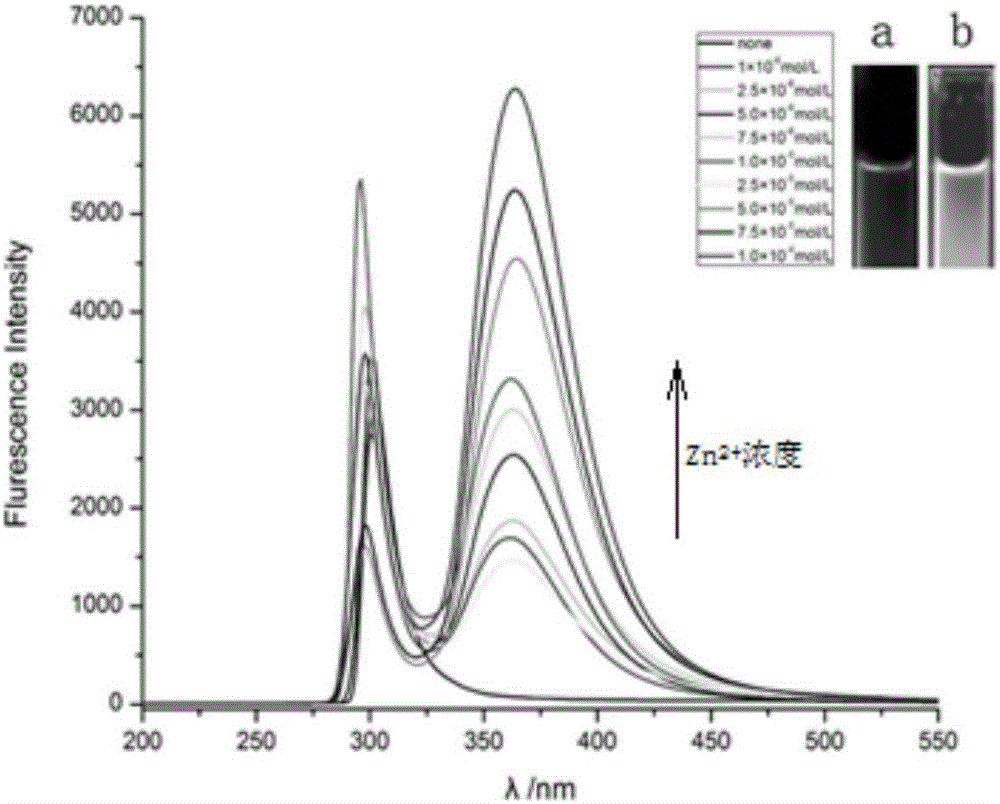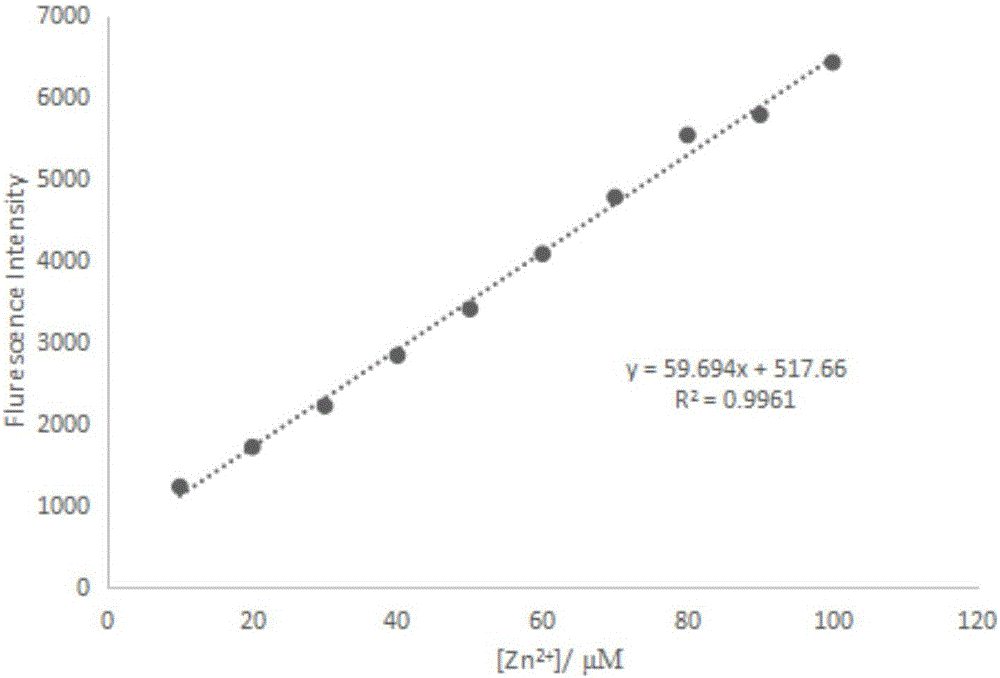Zinc ion fluorescent probe, preparation method and method for detecting zinc ion content
A fluorescent probe and zinc ion technology, applied in the field of fluorescence detection, can solve the problems of unstable detection results, limited popularization and application, complicated preparation process, etc., achieve good spatial control effect, increase fluorescence intensity, and simple detection method
- Summary
- Abstract
- Description
- Claims
- Application Information
AI Technical Summary
Problems solved by technology
Method used
Image
Examples
Embodiment 1
[0033] Preparation process: (1) Add 2-naphthol (0.144g, 1mmol), m-bromobenzaldehyde (0,185g, 1mmol), aniline (91μL, 1mmol) in sequence in a 50mL round bottom flask, stir and mix evenly; take TBAB ( 1mmol, 0.322g) and ammonium acetate (1mmol, 0.077g), dissolved in distilled water (10mL), stirred to form a transparent and clear solution, and added to the above mixture, reacted under microwave conditions at 60°C and 1atm for 4h. After the reaction solution was cooled, it was suction-filtered and washed with distilled water; the filter cake was recrystallized with 95vol% ethanol. Dry in an infrared oven at 200° C. for 20 minutes to obtain 0.345 g of a yellow solid, with a yield of 93%. The structural formula of the prepared fluorescent probe is:
[0034] The structure of the fluorescent probe is characterized as follows: IR(KBr,ν,cm -1 ):3334.97(s), 2887.41(w), 1601.03(s), 1496.65(m), 1229.43(s), 744.37(m); 1 H NMR (400MHz, CDCl 3 )δ (ppm): 11.34 (s, 1H, Ar-OH), 7.82-7.72 (m...
Embodiment 2
[0047] Preparation process: (1) Add 2-naphthol (0.144g, 1mmol), m-nitrobenzaldehyde (0.151g, 1mmol), aniline (91μL, 1mmol) in sequence in a 50mL round bottom flask, stir and mix evenly; TBAB (1mmol, 0.322g) and ammonium acetate (1mmol, 0.077g) were dissolved in distilled water (10mL), stirred to form a transparent and clear solution, added to the above mixture, and reacted under microwave conditions at 60°C and 1atm for 4h . After the reaction solution was cooled, it was suction filtered and washed with distilled water; the filter cake was recrystallized with 95% ethanol. Dry in an infrared oven at 300° C. for 20 minutes to obtain 0.336 g of a yellow solid, with a yield of 93%. The structural formula of the prepared fluorescent probe is:
[0048] The structure of the fluorescent probe is characterized as follows: IR(KBr, ν, m-1): 3609.56, 2936.45, 2896.23, 1603.21, 149.89, 1356.45, 1196.78; 1 H NMR (400MHz, CDCl 3 )δ (ppm): 8.40 (s, 1H, O-H), 8.06 (m, 1H, C-H), 7.93 (s, ...
Embodiment 3
[0054] Preparation process: (1) Add 2-naphthol (0.144g, 1mmol), m-nitrobenzaldehyde (0.151g, 1mmol) and hexahydropyridine (98μL, 1mmol) into a 50mL round bottom flask in sequence, and stir to mix evenly; Then take TBAB (1mmol, 0.322g) and ammonium acetate (1mmol, 0.077g), dissolve in distilled water (10mL), stir to form a transparent and clear solution, and add to the above mixture, at 60 ° C, 1 atm under microwave conditions Reaction 4h. After the reaction solution was cooled, it was suction filtered and washed with distilled water; the filter cake was recrystallized with 95% ethanol. Dry in an infrared drying oven at 250° C. for 30 min to obtain 0.355 g of a yellow solid, with a yield of 93%. The structural formula of the prepared fluorescent probe is:
[0055] The structure of the fluorescent probe is characterized as follows: IR(KBr,ν,cm -1 ):3626.29(w), 2953.47(w), 2811.51(w), 1620.41(m), 1449.05(m), 1343.15(s), 1237.06(m); 1 H NMR (400MHz, CDCl 3 )δ(ppm):8.40(s,1H...
PUM
 Login to View More
Login to View More Abstract
Description
Claims
Application Information
 Login to View More
Login to View More - R&D
- Intellectual Property
- Life Sciences
- Materials
- Tech Scout
- Unparalleled Data Quality
- Higher Quality Content
- 60% Fewer Hallucinations
Browse by: Latest US Patents, China's latest patents, Technical Efficacy Thesaurus, Application Domain, Technology Topic, Popular Technical Reports.
© 2025 PatSnap. All rights reserved.Legal|Privacy policy|Modern Slavery Act Transparency Statement|Sitemap|About US| Contact US: help@patsnap.com



